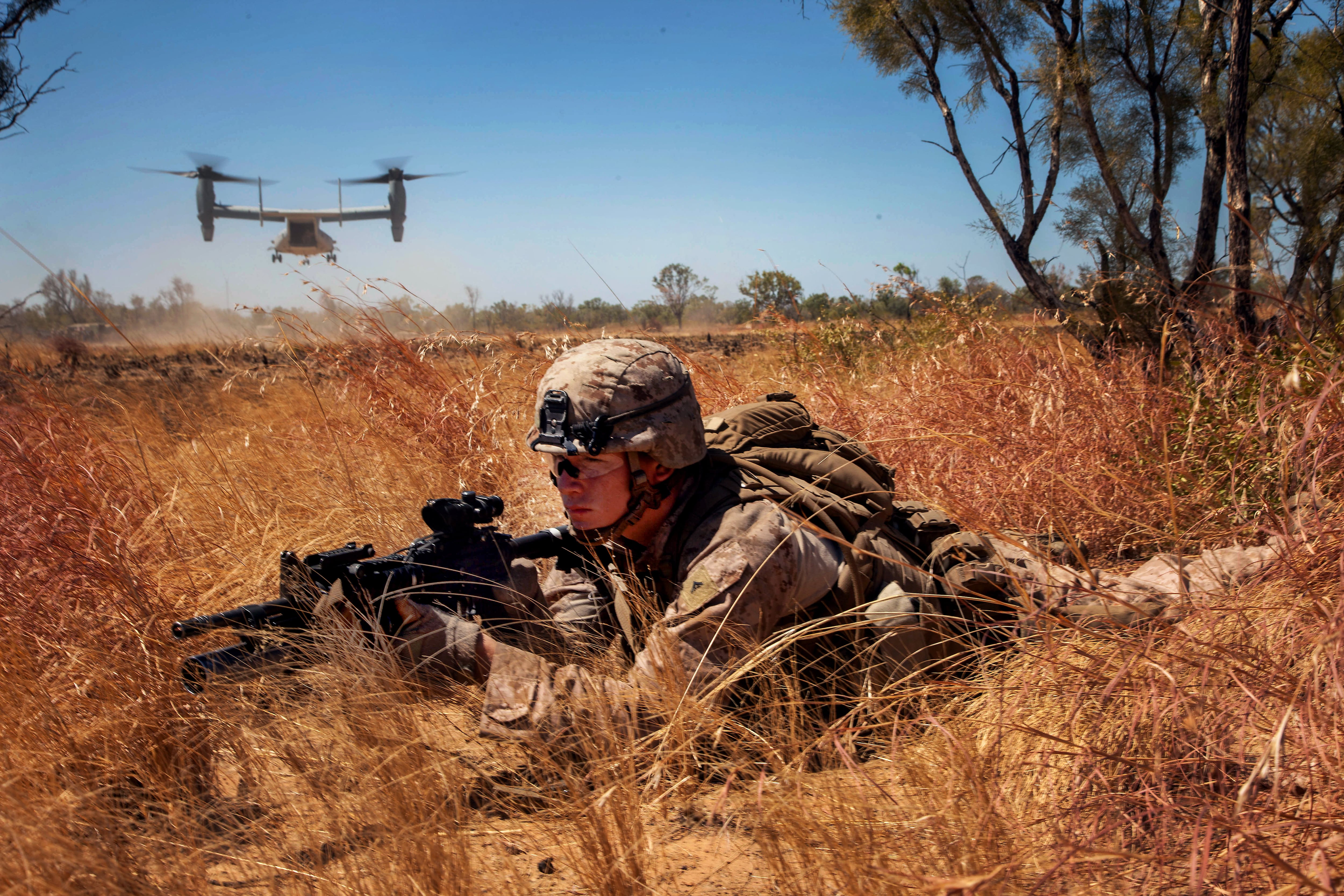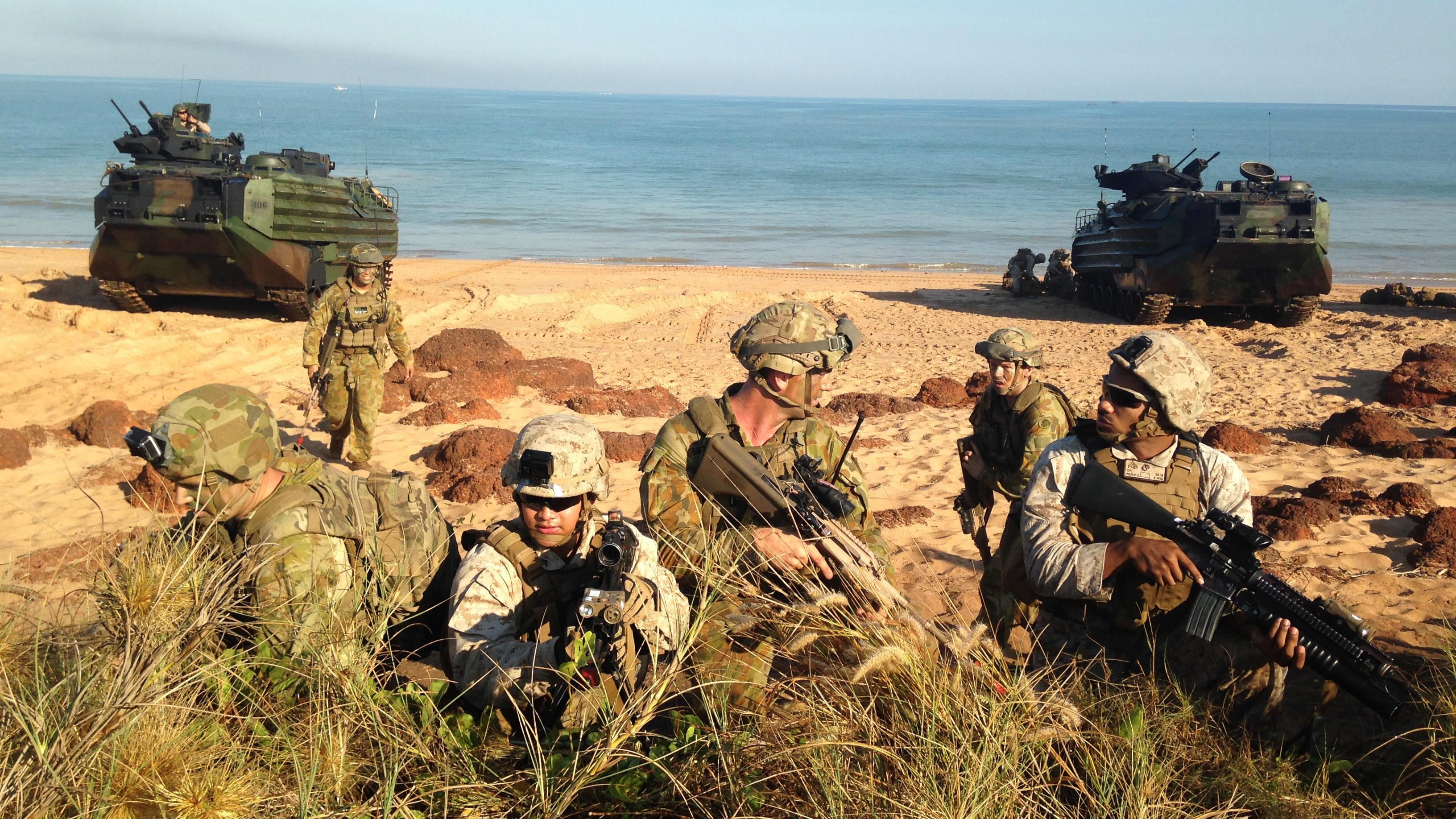The U.S. still plans to send 2,500 Marines to Australia each year — but that large of a rotation won't happen until at least 2020.
American and Australian officials are still slogging through the details of sending a full Marine air-ground task force Down Under to train alongside Aussie troops some five years after President Obama announced plans to send 2,500 Marines there annually starting in 2016 or 0r 2017.
The task force, known as Marine Rotational Force-Darwin, spends about six months of each year deployed to Australia's Northern Territory. The Marines began deploying there soon after the Obama administration announced its Pacific pivot, a policy that reoriented resources after the wars in Iraq and Afghanistan to counter China's rise.
Australian defense officials declined to say exactly why the timeline was pushed back, but confirmed they’re working with the U.S. to bring a full MAGTF through Darwin in "by around 2020." "about" four years.
"Each year the U.S. and Australia work closely together to determine the exact size and composition of each rotation in addition to the activities that the Marine Rotational Force-Darwin will undertake during their six-month deployment to the region," Each year the U.S. and Australia work closely together to determine the exact size and composition of each rotation," said the official, who spoke on condition of anonymity.

Marine Lance Cpl. John Ready provides security as an MV-22 Osprey takes off during a live-fire exercise in Australia.
Photo Credit: Lance Cpl. Tyler Dietrich/Marine Corps
There are currently task force, known as Marine Rotational Force-Darwin, currently includes about 1,250 Marines in Australia. and four UH-1Y Venom helicopters. The rotations have expanded to a battalion landing team since the first company-size deployment — about 200 Marines — in April 2012, just months after the U.S. and Australia announced the initiative.
Since then, there have been about six rounds of negotiations between the countries as officials trying to hammer out how costs should be shared and facilities used, said according to Andrew Shearer, a former Australian national security adviser who's now with senior adviser advisor on Asia Pacific security at the Center for Strategic and International Studies, a Washington think tank and former Australian national security adviser.
"What seems to have happened is basically those negotiations have bogged down pretty badly," he said. "I think that's quite unfortunate."
While another Taking the broad view, 1,250 Marines in Australia isn't likely to will not tip the strategic balance in the western Pacific, Shearer he said, delaying the plan but pushing that back sends the wrong an unhelpful signal at a time when tensions are growing in the South China Sea.
Obama's November 2011 announcement to send in the Marines marked the beginning of his administration's 'pivot to the Pacific' as the U.S. military looked beyond Iraq and Afghanistan.
Sharing the costs
The U.S. and Australia have invested millions to boost the size of the Marine rotations — but both militaries are facing budget crunches, and that has created some friction.
As the Marine Corps ramps up rotations to Japan, Australia and eventually Guam, the service has allocated billions of dollars to fund those moves. And the Aussies spent $11 million upgrading army and air force bases to accommodate more U.S. Marines in the Northern Territory.
But Shearer said the two countries need to focus on the long-term benefits to the agreement instead of getting bogged down in budget negotiations.
"From my understanding, the difference between the two sides is a few tens 10s of millions of dollars annually," he Shearer said. "Both sides need to get back to focusing on the big picture ... and the long-term benefits to both countries rather than this sort of unseemly haggling."
The agreement benefits both sides, he said. Rotating more Marines a full MAGTF through Australia is just one a key piece of the Marine Corps' re-balancing of American forces. In coming years, the Marine Corps plans to base roughly 15 percent of its force in Hawaii and beyond in coming years. And the Aussies are in the process of standing up their first-ever marine amphibious force, according to a white paper released this spring that completely revamped Australia's defense strategy.

Marines and Australian soldiers conduct an amphibious assault exercise during Talisman Sabre in Fog Bay Australia. The Australian military is working to stand up its first marine amphibious force.
Photo Credit: Sgt. Sarah Anderson/Marine Corps
Having Marines and Australian soldiers training together closely will be vital to that strategy's success, Shearer said.
"Australia will operate at extended ranges and be able to shape and influence out into maritime Southeast Asia," he Shearer said. "What’s laid out in the white paper is really the biggest modernization of the Royal Australian Navy since the Second World War."
That strategy calls for a greater emphasis on a more aggressive maritime strategy. Its marine amphibious force will be built around two new Canberra-class landing helicopter dock assault ships. The plan also includes a $90 billion investment in shipbuilding over the next decade.
The 1,250 Marines currently deployed to Australia will train with local soldiers through October. Most are housed atThe Marines train in Australia’s Northern Territory from about April through October each year and are housed at the Australian army's Robertson Barracks, with some staying at the nearby Royal Australian Air Force Base Darwin. outside of Darwin.
Most of this year’s rotation are from 1st Battalion, 1st Marines out of Marine Corps Base Camp Pendleton, California, according to Chuck Little, a spokesman for U.S. Marine Corps Forces Pacific. They have an aggressive training schedule that will include working with the Australians, including several bilateral exercises, and "may also deploy to other countries to participate in multilateral security cooperation activities," he said in an email.
The Australians gain a lot from this as well as it seeks to stand up its first ever marine amphibious force built around two newly-built Canberra-class landing helicopter dock assault ships.
This Spring, the Australian military released its 2016 Defence White Paper, which outlines a sweeping overhaul of its defense strategy with a greater emphasis on a more aggressive maritime strategy.
"Australia will operate at extended ranges and be able to shape and influence out into maritime Southeast Asia," Shearer said. "What's laid out in the white paper is really the biggest modernization of the Royal Australian Navy since the Second World War."
The plan also includes a $90 billion investment in shipbuilding over the next decade.
However, with both the U.S. and Australia facing military budget crunches, the sharing of costs for the joint MRF-D training has become a sticking point.
"From my understanding, the difference between the two sides is a few 10s of millions of dollars annually," Shearer said. "Both sides need to get back to focusing on the big picture and the long-term benefits to both countries rather than this sort of unseemly haggling."
Senior reporter Jeff Schogol contributed to this report.
Matthew L. Schehl covers training and education, recruiting, West Coast Marines, MARSOC, and operations in Europe, Africa and the Middle East for Marine Corps Times. He can be reached at mschehl@marinecorpstimes.com.




